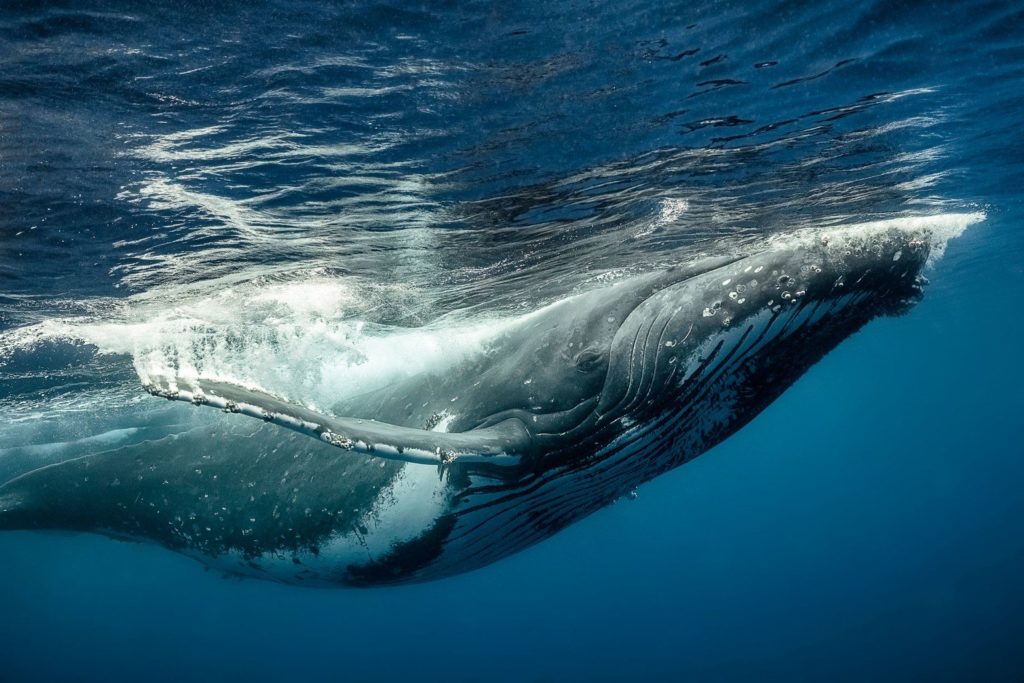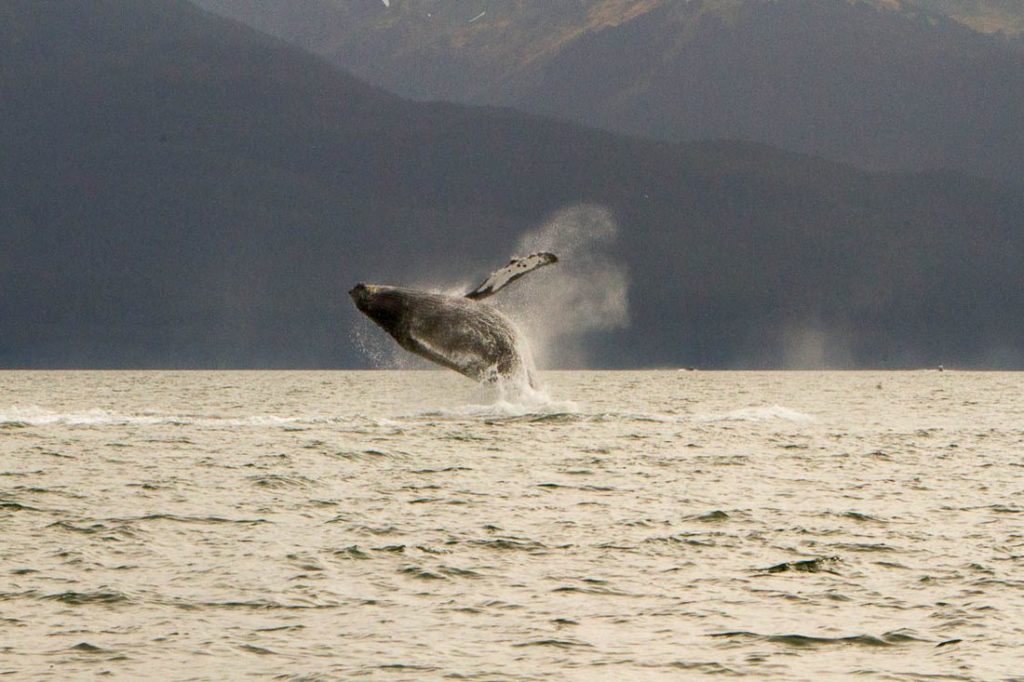The year 2016 was remarkable for British great whale records, including a blue whale photographed just outside UK waters, and the sad stranding of several sperm whales on North Sea coasts. But perhaps the most exciting place to be was Shetland, where orcas spent much of the summer a stone’s throw offshore and social media ensured everyone knew exactly where to look. Then, in November, humpback whales were reported in the north-east of the archipelago. Local naturalists Richard Shucksmith and Brydon Thomason knew they had to react quickly. “Humpback sightings in Shetland have increased recently, but usually they’re just passing through, so you have to take your chance to see them,” says Brydon. This time, however, the whales stuck around, with up to five using the area. The unprecedented frequency of sightings presented the exciting possibility of decent photos and something never before managed in British waters – underwater footage.

“Shetland’s great for underwater photography,” says Richard. “We routinely get visibility of 10-15m, compared to 5-6m in somewhere like the North Sea. The problem is the weather – calm days can be few and far between.” Unfortunately for Richard, a perfect weather window in early December clashed with a trip south, and he was boarding a plane as Brydon set out with another friend, Peter Hunter, in Peter’s small boat. “It was awful,” says Richard. “I was on the runway getting text messages from Brydon saying ‘This is amazing, where are you?’” Brydon’s excitement was justified. He and Peter had located two large adult humpbacks and watched from a cautious distance as the whales repeatedly circuited a small area. Peter slowly manoeuvred his boat into an intercepting position, then turned off the engine and waited. “It was important not to disturb the whales,” Brydon says. “Instead we gave them the chance to come to us if they wanted.”
As it turned out, the whales were exceptionally inquisitive. They approached the boat repeatedly, sometimes as dose as 10m, spyhopping, tail-lobbing, slapping the water with their huge pectoral fins and even breaching. Brydon took a series of spectacular photos, including clear shots of the uniquely patterned tail flukes, which he sent to the Sea Watch Foundation and North Norwegian Humpback Whale Catalogue and posted online to see if anyone had a match. By the time Richard returned to Shetland, the weather had dosed in. “But the next Monday, I walked out to one of the headlands. About a kilometre out, I spotted two huge blows. Over the next 10 minutes two humpbacks swam directly towards us until they were no more than 6-7m out.” This proved a good omen, and when the next day dawned bright and calm, Brydon and Richard set out together with Peter. “We had to be quick,” Richard explains. “It was only a week off midwinter, and we couldn’t expect more than three hours’ decent light.” With luck on their side they found two circuiting whales easily and manoeuvred into position. As the whales came into view, Richard slipped into the water. “I felt a real nervous excitement. The more time you spend around wildlife, the more you realise that every animal is different. I didn’t know how they’d react.”

A TASTE OF THINGS TO COME?
Experience with other cetaceans has taught Richard to move as little as possible. “I just floated quietly, looking though the camera. Then I heard a blow very close and popped my head up -I couldn’t believe how near they were. I looked down again and in my peripheral vision these huge dark shapes loomed up. They cruised past, then turned back to swim under me. It was striking how ‘bendy’ they were – you wouldn’t think they could twist and turn so easily. They really checked me out, and all the time I was thinking ‘This is in Shetland!’”
Meanwhile, Brydon was filming from the boat “I could tell these weren’t the same whales, not least by their smaller size, but their behaviour was also very different, as they were far less inquisitive.” Does that reflect different personalities or moods, I wonder? “Possibly. They were smaller animals, probably sub-adult. The behavioural difference was perhaps just what they were doing at the time. ” It’s exciting to imagine that Richard and Brydon’s experience may well be a taste of things to come. The humpbacks were still being seen around Shetland in mid-January, and with other sightings in the Hebrides, off the Moray Firth, and as far south as the Yorkshire coast last summer, it seems there has never been a better time to see great whales in and around the British Isles. Peter Evans has spent a career monitoring cetaceans around Britain and Ireland as founder and director of the Brydon’s photo shows a spectacular ‘belly-up’ breach. The sound can carry hundreds of metres underwater.

Sea Watch Foundation, celebrating its 25th anniversary in 2017. “A variety of evidence indicates that humpback populations have been increasing in the north-west Atlantic,” he says. “Most of them breed in the West Indies, and there’s a small breeding population in the Cape Verde Islands, off north-western Africa. We’re also seeing some recovery in potential prey species. In the UK, you tend to see humpbacks where there’s a LOT of food around.” Humpbacks are well known to eat herrings, sprats and sandeels, and it seems likely they also take mackerel. “We often see humpbacks in UK and Irish waters in association with both herring and mackerel shoals,” says Evans, “but because mackerel are themselves predators of smaller fish, we can’t yet say whether the whales are hunting them or just targeting the same small prey.”
In the first of Brydon’s encounters the humpbacks were associated with massive mackerel shoals, but firm proof of mackerel hunting has eluded him and Richard so far. But there was another stunning revelation in store. Brydon sent good identifiable tail-fluke images of two of the five individuals to relevant organisations for possible matches. Neither the North Norwegian Humpback Whale Catalogue or The Irish Whale and Dolphin Group (IWDG), whose previous records links Irish humpbacks to Norway, Iceland, the Netherlands and even Gibraltar, had a match. But Padraig Whooley of IWDG put Brydon in touch with the world’s largest humpback ID database, the North Atlantic Humpback Whale Catalogue in Maine, USA.
STUNNING REVELATION
The reply was thrilling. The first-ever match for a UK or Irish humpback to a breeding area. Only it wasn’t Cape Verde, the main humpback breeding ground this side of the Atlantic. Amazingly, the Shetland whale in question was last recorded in March 2016 by Cedric Milion, a tour guide from Guadeloupe Evasion Decouverte, in the Caribbean – an ocean away. “I just couldn’t believe it,” exclaims Brydon. “To get such a significant match from the first tail-fluke ID attempt from Shetland was remarkable – and lucky!” Peter Evans had been waiting for just such a result. “We’ve been looking for some time at possible links with the expanding western Atlantic population. Western humpbacks may travel here via Iceland and Norway, which would explain why we’re seeing them more around the north of Britain.

What’s also interesting is that we’re seeing them here in winter, when most west Atlantic breeding adults are on their breeding grounds.” Perhaps, Evans speculates, the Shetland animals aren’t quite fully mature. “Or maybe they’re taking a year off -humpbacks don’t breed every year. Or maybe,” he adds very tentatively, “maybe with global warming, some are remaining overwinter and even breeding further north than before. We’ve never seen young calves here, so can’t yet say that’s happening, but it’s something to look for.” As with all exciting insights, this one raises more questions than it answers. There’s much still to learn -and with technological advances and more contributions from citizen scientists, the data is coming in fast. But most encouraging of all, says Brydon, is the fantastic international collaboration he and Richard saw. “It was so inspiring.”














